Best ways to help winter animals this Christmas
- Dec 23, 2015
- 3 min read
It’s the most wonderful time of the year … for plenty of us. But the holiday season is not a happy one for many of the world’s winter animals, which increasingly face a variety of threats, from extinction and oil spills to hunting and habitat loss. I’ve rounded up a few of my favorite winter animals, along with some smart ways we can all help winter animals survive and thrive for generations to come:
Arctic fox
Like many of the winter animals on this list, the Arctic fox is threatened by climate change, which changes the snow line and pushes them into new areas lacking prey. But they face another danger, too: the fur trade. You can help Arctic foxes and other animals used for their fur by living fur-free and just saying no to fur. PETA offers this pledge on their website; you can also tweet your support with hashtags #FurFreeFriday and #FurFreeForever. Learn more about the arctic fox here on the WWF website.
Bunnies
Here’s an easy way you can help bunnies this Christmas season: Buy cruelty-free cosmetics from companies like Lush, Too Faced, Urban Decay, Tarte, Bare Minerals and more. Check out a full list from the Cruelty-Free Kitty blog here. Also visit Leaping Bunny Program’s searchable database, which makes compassionate shopping a cinch. There are other ways to help rabbits, too: You can tweet about the cause with hashtag #BeCrueltyFree, and support charities that rescue bunnies, such as House Rabbit Society in Richmond, California.
Moose
Forest changes, parasites and rising temperatures caused by global climate change are hurting moose populations across the U.S. and Canada. Even worse, moose are still hunted legally, as they are not protected by the Endangered Species Act. The Center for Biological Diversity hopes to change that; the wildlife protection group has asked the U.S. Fish and Wildlife Service to reconsider the animal’s status. What can you do? To support and save the country’s moose population, sign and send this petition today to your local senators.
Owls
Northern spotted owls are losing their forest habitats from logging, and the numbers of tawny owls in Britain have fallen over the past two decades. There are some things you can do, like create D.I.Y. nesting boxes for barn owls and offer the right help to any injured owls you come across (always contact your local wildlife rescue). Organizations like The Owls Trust and The World Owl Trust are dedicated to protecting these mysterious, majestic creatures.
Penguins
Penguins are so dapper and cute—but they also face tremendous risks in the wild, many of them man-made, from oil spills and climate change to newly introduced predators (like feral cats) and overfishing. You can help to support the world’s beautiful penguins in a few places: Australia’s Penguin Foundation, the WWF and the Ocean Conservancy, to name a few. And make sure to mark your calendars for January 20: Penguin Awareness Day!
Polar bears
Polar bears are losing Arctic sea ice—and with it, their all-important habitat. With the species as a whole decreasing in number, and official recognition as endangered due to global warming, what can we do? Check out Polar Bears International and the wonderful work they do to ensure we see “this iconic species roaming the sea ice for generations to come.” Their site includes petitions, a cool polar bear tracker map and an amazing polar bear cam (with wild bears roaming around!). It’s not all bad news, though: Researchers from the Norwegian Polar Institute just announced they are seeing bears in their area possibly making a comeback and promising signs that the bears are learning to adapt to some of the effects of climate change. Donate to Polar Bears International here.
Wolves
Often, the best way to ensure biodiversity and save crucial habitats is to protect the predators—in this case, wolves. But amazingly, the opposite is happening in our forests, with wolf hunting regulated and allowed in Idaho and Montana. Indiscriminate trapping and lethal means of protecting livestock are also big problems. But the species is in danger, and advocacy group Howling for Wolves, founded by Dr. Maureen Hackett, is fighting for non-lethal alternatives and tolerance to save Minnesota’s gray wolves from decline. Defenders of Wildlife and Howling for Wolves are two nonprofits that can help wolves with your financial donation. Not to be missed: Here are 7 Reasons to Let Wolves Live, from Howling for Wolves.




Comments